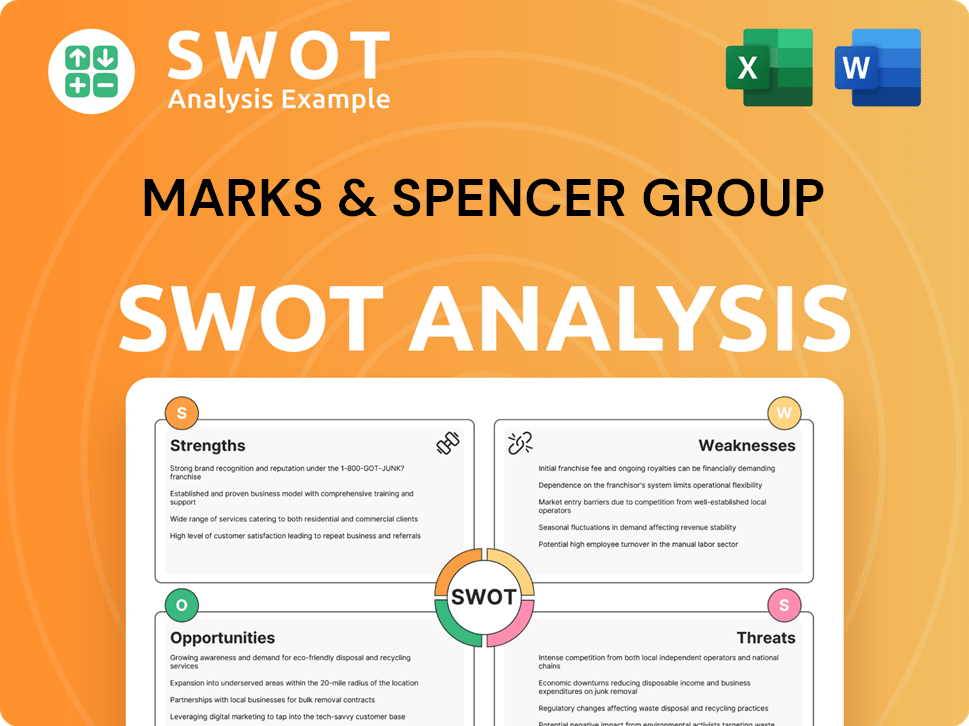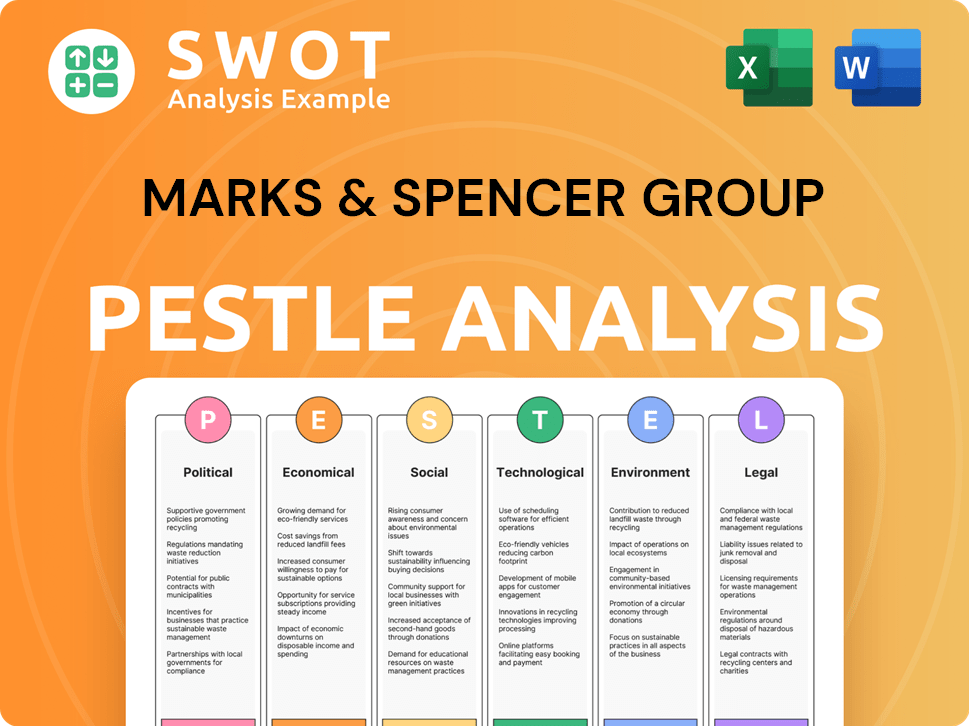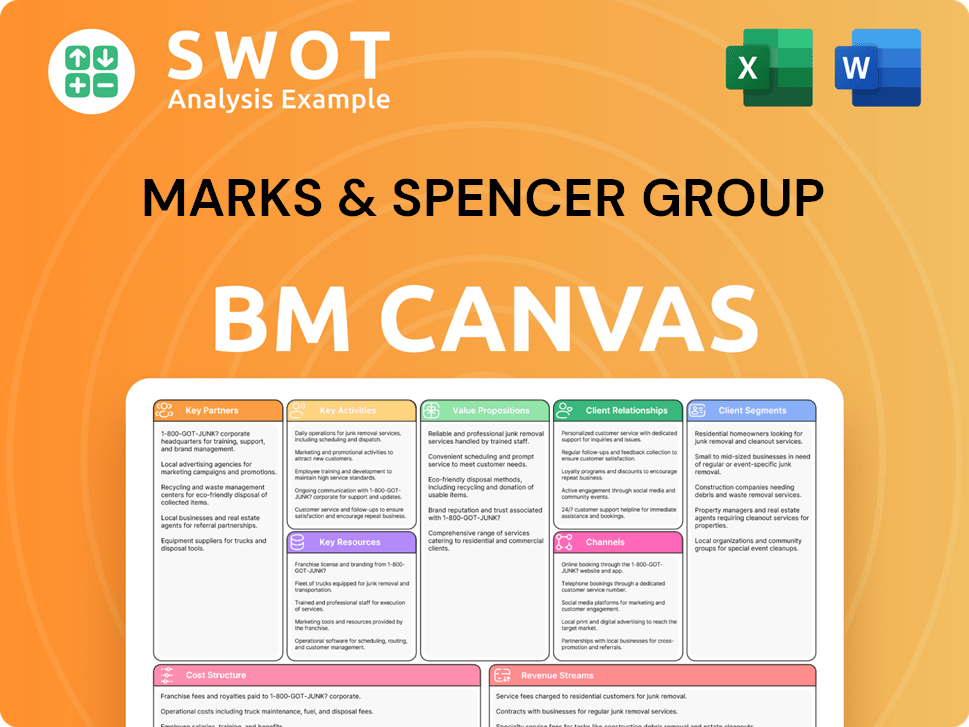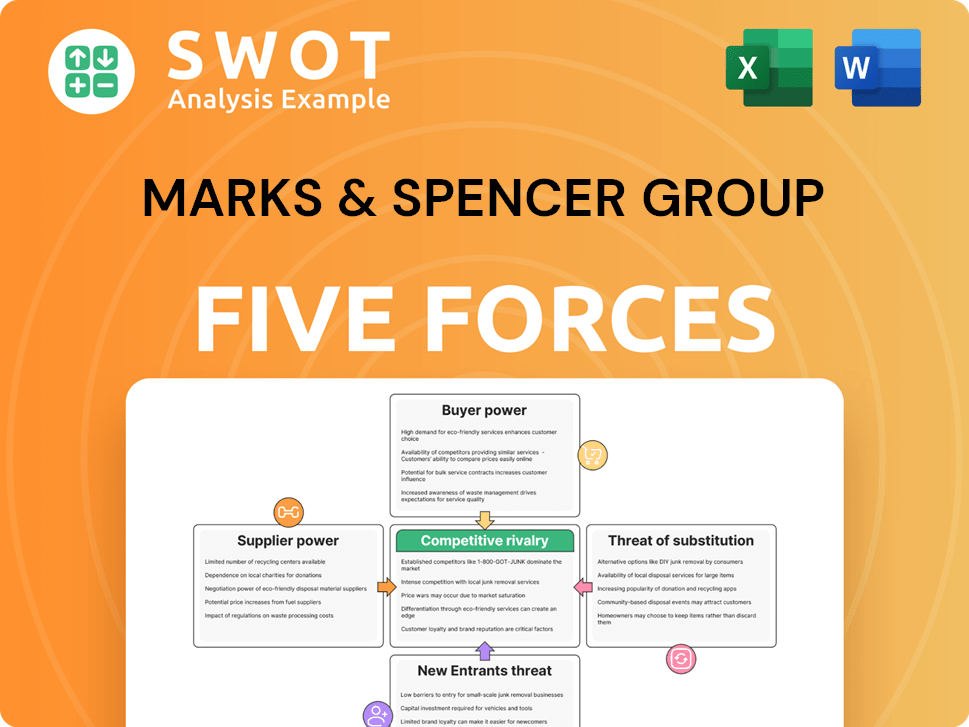Marks & Spencer Group Bundle
How Does Marks & Spencer Stay Ahead in the Retail Game?
In the fast-paced world of retail, understanding the Marks & Spencer Group SWOT Analysis is crucial for success. Marks & Spencer (M&S) has continually adapted its sales and marketing strategies to stay relevant. This deep dive explores how M&S has transformed its approach to meet modern consumer demands and maintain its iconic status.

From its humble beginnings as a penny bazaar to its current omnichannel presence, M&S's journey showcases the importance of a robust M&S sales strategy. This analysis will dissect the Marks & Spencer marketing strategy, examining its evolution and the key elements driving its success in a competitive market. We will also explore Marks and Spencer strategy in terms of customer engagement, M&S Group brand positioning, and innovative campaigns, providing actionable insights for retail and business strategists.
How Does Marks & Spencer Group Reach Its Customers?
The sales strategy of Marks & Spencer (M&S) is multifaceted, employing a blend of physical retail and digital channels to connect with its customer base. This approach allows the company to cater to diverse shopping preferences and market segments. The evolution of M&S's sales channels reflects its adaptability to changing consumer behaviors and market dynamics, particularly the shift towards online shopping.
M&S's sales strategy focuses on both online and offline channels. Physical stores, a cornerstone of the company's strategy, include large department stores and smaller food-focused outlets. Simultaneously, M&S has invested heavily in its e-commerce platform, enhancing user experience and logistics to meet the growing demand for online shopping. This omnichannel approach allows customers to shop seamlessly across different channels.
The company's strategy includes strategic partnerships to expand its reach. A key example is the collaboration with Ocado Retail, which allows M&S Food products to be delivered through Ocado's online platform. This partnership has been instrumental in expanding M&S's online presence and competitiveness in the online grocery market.
Physical stores remain a crucial part of the M&S sales strategy, with a significant presence in the UK and some international locations. These stores vary in size and format, including large department stores and smaller food stores. M&S has been modernizing its stores and closing underperforming locations to improve the in-store experience.
The company's website, marksandspencer.com, is a key sales channel. M&S has invested significantly in its online capabilities, improving user experience, logistics, and delivery options. Online sales have become increasingly important, with Clothing & Home online sales growing by 25.1% in the 13 weeks to December 30, 2023. This growth contributed to an overall Clothing & Home sales increase of 14.7%.
M&S uses an omnichannel strategy that allows customers to transition between online and in-store shopping seamlessly. This includes options like in-store pickup (Click & Collect) and in-store returns. This integration enhances convenience and customer satisfaction. The omnichannel approach supports the overall M&S sales strategy.
Partnerships are important for expanding M&S's reach. The collaboration with Ocado Retail allows M&S Food products to be delivered through Ocado's online platform. This partnership, which began in September 2020, has been crucial for expanding M&S Food's online presence and competing in the online grocery market. Learn more about this in Revenue Streams & Business Model of Marks & Spencer Group.
M&S employs a multi-channel sales approach. This includes physical stores, a strong online presence, and strategic partnerships to reach its target audience effectively. The company's focus on integrating these channels provides customers with a convenient and consistent shopping experience.
- Physical Retail: Large department stores and smaller food stores.
- E-commerce: Marksandspencer.com, with significant investment in user experience and logistics.
- Omnichannel: Seamless integration between online and in-store shopping.
- Strategic Partnerships: Collaborations like the one with Ocado Retail.
Marks & Spencer Group SWOT Analysis
- Complete SWOT Breakdown
- Fully Customizable
- Editable in Excel & Word
- Professional Formatting
- Investor-Ready Format

What Marketing Tactics Does Marks & Spencer Group Use?
The marketing tactics employed by the [Company Name] are multifaceted, designed to build brand awareness, generate leads, and boost sales across various channels. The strategy integrates both digital and traditional media to reach a wide customer base. This approach is crucial for maintaining a competitive edge in the retail market.
Digital marketing forms a core part of the [Company Name]'s strategy, with a strong emphasis on content marketing, SEO, and paid advertising. Social media platforms also play a key role in engaging with customers and showcasing products. Furthermore, the company leverages data-driven marketing to personalize customer experiences and optimize campaign effectiveness.
Traditional marketing methods, such as TV and print advertising, continue to be used, especially for seasonal campaigns. The company's approach to marketing has evolved, with a clear shift towards digital-first strategies while still maintaining a presence in traditional media. The marketing mix has adapted to changing consumer behaviors and market trends.
Content marketing is a key element of the digital strategy, with the company using its website, blog, and social media to share fashion advice, home decor inspiration, and recipes. This approach helps engage customers and showcase products effectively. Content marketing drives organic traffic and enhances brand visibility.
SEO is crucial for ensuring high visibility in online searches for clothing, home goods, and food items. This drives organic traffic to its e-commerce platform. Effective SEO helps the company capture a larger share of the online market.
Paid advertising, including search engine marketing (SEM) and display advertising, targets specific customer segments and promotes seasonal collections. These campaigns are designed to boost sales during key periods. Paid advertising ensures that the company reaches its target audience effectively.
Email marketing is a key tool for direct customer communication, delivering personalized promotions, new product alerts, and loyalty program updates. This approach helps maintain customer engagement and drive repeat purchases. Email marketing is essential for customer retention.
Social media platforms (Instagram, Facebook, and TikTok) are used for brand engagement and product showcasing, often with influencer collaborations. This helps reach broader and younger demographics. Social media marketing is vital for modern brand building.
Traditional media, including TV, radio, and print advertisements, continue to be part of the marketing mix, especially for major seasonal campaigns. This ensures broad reach and brand reinforcement. Traditional media remains relevant for brand building.
The evolution of the company's Marks & Spencer marketing strategy reflects a clear shift towards digital-first approaches, while still utilizing traditional media. The company's approach to M&S sales strategy is becoming increasingly sophisticated, using customer data to segment its audience and personalize marketing messages. This involves analyzing purchase history, browsing behavior, and demographic information to tailor product recommendations and promotions, enhancing the relevance and effectiveness of its campaigns. For more insights, you can read about the Growth Strategy of Marks & Spencer Group.
The company utilizes customer data to segment audiences and personalize marketing messages. This involves analyzing purchase history, browsing behavior, and demographic information to tailor product recommendations and promotions. This enhances the relevance and effectiveness of campaigns.
- Customer data is used to segment audiences.
- Purchase history and browsing behavior are analyzed.
- Demographic information informs tailored promotions.
- Advanced CRM systems and marketing automation platforms are utilized.
Marks & Spencer Group PESTLE Analysis
- Covers All 6 PESTLE Categories
- No Research Needed – Save Hours of Work
- Built by Experts, Trusted by Consultants
- Instant Download, Ready to Use
- 100% Editable, Fully Customizable

How Is Marks & Spencer Group Positioned in the Market?
The brand positioning of the company, a prominent player in the retail sector, centers on a heritage of quality, trust, and value. This positioning is carefully crafted to differentiate it from competitors, emphasizing well-made products across clothing, home goods, and food. The core message often revolves around 'quality you can trust' and 'making every day special,' resonating with a broad demographic that values reliability and a certain level of sophistication. This approach is critical to the company's overall Owners & Shareholders of Marks & Spencer Group strategy.
The company's visual identity is classic and understated, employing familiar fonts and a color palette that evokes heritage and understated elegance. The tone of voice in its marketing and customer interactions is generally friendly, approachable, and authoritative, reflecting its status as a trusted household name. This consistent branding helps reinforce the company's commitment to providing a reliable and enjoyable shopping experience across all its channels.
The company's strategy involves a multi-pronged approach to appeal to its target audience. In food, it emphasizes freshness, provenance, and innovation, positioning itself as a premium yet accessible option. For clothing, it has focused on contemporary fashion, fit, and sustainable materials. The company's 'Jeans for Life' campaign highlighted durability and quality. The company has also been recognized for its sustainability efforts, with positive perception for its 'Plan A' initiative, which focuses on ethical sourcing, reducing environmental impact, and community involvement.
The company's sales strategy is deeply intertwined with its brand positioning. It focuses on delivering quality products and a consistent customer experience across all channels. This includes physical stores, online platforms, and strategic partnerships. The company aims to enhance sales through product innovation and customer engagement.
The company's marketing strategy is designed to build brand loyalty and attract new customers. This involves targeted advertising campaigns, social media engagement, and loyalty programs. The company also focuses on promoting its sustainability initiatives and highlighting its commitment to quality and value.
The company targets a broad demographic that values quality, trust, and value. This includes families, professionals, and individuals seeking reliable and stylish products. The company's marketing efforts are tailored to resonate with this diverse audience, emphasizing both everyday essentials and special occasion items.
The company's competitive advantage lies in its strong brand reputation, commitment to quality, and focus on sustainability. It differentiates itself through its product offerings, customer service, and strategic partnerships. The company continues to adapt to market changes to maintain its competitive edge.
The company employs a market segmentation strategy to target specific customer groups. This involves tailoring product offerings and marketing messages to meet the needs of different demographics and lifestyle segments. This approach helps the company maximize its sales and marketing effectiveness.
The company has increased its digital marketing initiatives to enhance online sales and customer engagement. This includes optimizing its website, using social media platforms, and implementing targeted advertising campaigns. The company is focused on improving its digital presence to reach a wider audience.
The company emphasizes customer relationship management to build loyalty and improve customer satisfaction. This involves collecting customer data, personalizing marketing messages, and providing excellent customer service. The company aims to create a positive shopping experience for all customers.
The company's product development strategy focuses on innovation and quality. This involves introducing new products, improving existing ones, and sourcing sustainable materials. The company aims to meet the evolving needs of its customers while maintaining its commitment to quality.
The company utilizes advertising campaigns to promote its brand and products. These campaigns are designed to resonate with its target audience and highlight its key selling points. The company's advertising efforts are carefully planned to maximize their impact and effectiveness.
The company conducts regular sales performance analysis to assess its effectiveness. This involves tracking sales data, identifying trends, and making data-driven decisions. This analysis helps the company improve its sales strategies and optimize its performance.
Marks & Spencer Group Business Model Canvas
- Complete 9-Block Business Model Canvas
- Effortlessly Communicate Your Business Strategy
- Investor-Ready BMC Format
- 100% Editable and Customizable
- Clear and Structured Layout

What Are Marks & Spencer Group’s Most Notable Campaigns?
The Marks & Spencer marketing strategy has consistently involved impactful campaigns, particularly during key seasonal events. Christmas advertising is a cornerstone, aiming to evoke emotional connections and drive sales during the festive period. These campaigns are crucial for maintaining brand relevance and boosting revenue, as demonstrated by the success of recent initiatives like the 'Love Thismas (Not Thatmas)' campaign.
In the clothing and home divisions, the M&S sales strategy focuses on highlighting quality, fit, and sustainability. Campaigns such as 'Anything but Ordinary' aim to reposition the brand as a modern fashion destination. The strategy includes digital content, in-store displays, and influencer partnerships to reach a broader audience. This approach aims to increase footfall and online sales, reflecting a broader effort to revitalize the clothing division.
Collaborations also play a vital role in the M&S Group's marketing efforts. The partnership with Ocado Retail enhances the visibility and accessibility of M&S Food in the online grocery market. These strategic alliances, along with ongoing efforts to adapt to the changing retail landscape, are key components of the company's marketing plan.
The Christmas campaigns are central to M&S's marketing. The 'Love Thismas (Not Thatmas)' campaign in 2023 featured various celebrities. These campaigns are promoted across multiple channels to engage customers and boost sales during the holiday season.
The 'Anything but Ordinary' campaign in 2023 highlighted the versatility and quality of everyday wear. This campaign used digital content and influencer partnerships. The goal was to increase footfall and online sales by repositioning M&S as a contemporary fashion brand.
M&S partners with Ocado Retail to enhance its brand visibility and accessibility. Historically, M&S has collaborated with well-known figures. These partnerships are part of M&S's broader strategy to engage with customers.
Ongoing efforts to revitalize the clothing division involve significant marketing efforts. These include communicating strategic shifts and brand promises. Adapting to the changing retail landscape is a key focus for M&S.
Marks & Spencer Group Porter's Five Forces Analysis
- Covers All 5 Competitive Forces in Detail
- Structured for Consultants, Students, and Founders
- 100% Editable in Microsoft Word & Excel
- Instant Digital Download – Use Immediately
- Compatible with Mac & PC – Fully Unlocked

Related Blogs
- What are Mission Vision & Core Values of Marks & Spencer Group Company?
- What is Competitive Landscape of Marks & Spencer Group Company?
- What is Growth Strategy and Future Prospects of Marks & Spencer Group Company?
- How Does Marks & Spencer Group Company Work?
- What is Brief History of Marks & Spencer Group Company?
- Who Owns Marks & Spencer Group Company?
- What is Customer Demographics and Target Market of Marks & Spencer Group Company?
Disclaimer
All information, articles, and product details provided on this website are for general informational and educational purposes only. We do not claim any ownership over, nor do we intend to infringe upon, any trademarks, copyrights, logos, brand names, or other intellectual property mentioned or depicted on this site. Such intellectual property remains the property of its respective owners, and any references here are made solely for identification or informational purposes, without implying any affiliation, endorsement, or partnership.
We make no representations or warranties, express or implied, regarding the accuracy, completeness, or suitability of any content or products presented. Nothing on this website should be construed as legal, tax, investment, financial, medical, or other professional advice. In addition, no part of this site—including articles or product references—constitutes a solicitation, recommendation, endorsement, advertisement, or offer to buy or sell any securities, franchises, or other financial instruments, particularly in jurisdictions where such activity would be unlawful.
All content is of a general nature and may not address the specific circumstances of any individual or entity. It is not a substitute for professional advice or services. Any actions you take based on the information provided here are strictly at your own risk. You accept full responsibility for any decisions or outcomes arising from your use of this website and agree to release us from any liability in connection with your use of, or reliance upon, the content or products found herein.